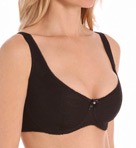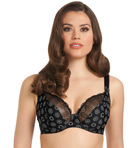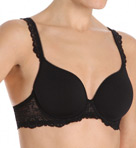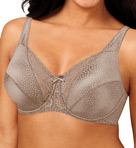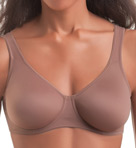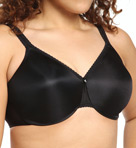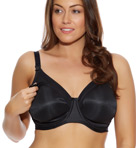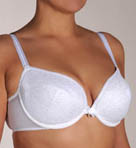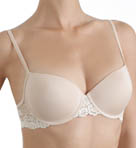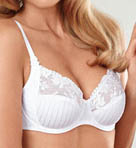 |
|||||
Bra Cup StylesWithin each bra style, there is a subset of cup styles. So, it's important to understand the many different cup styles in order for your bra choice to meet your requirements. Here is a list of the many bra cup styles.
Balconette CupsBalconette cups are a little smaller than demi cups. A true balconette cup will be cut horizontally just above the bust line and give ones breasts the look of fullness and uplift. They will also have vertical seams just under the bust to give added boost. Many manufacturers call bras balconette bras when in fact they are not. A balconette cup usually has a little padding to enhance bust size as well. The name balconette comes from men in the balcony of a theater looking down upon women -- a balconette bra could not be seen from above. Back to top Balcony CupsBalcony style cups give a sweetheart shape to the neckline. The center panel is usually lower to achieve this look, and a balcony cup has less coverage than a full coverage cup. Back to top Contour CupsContour cups hold their shape, even when not worn. These cups have an underwire and are lined with a thin layer of foam or fiberfill lining that is molded into a specific shape. Contour cups are a perfect choice for any woman seeking a sculpted silhouette, as they offer a specific round and symmetrical breast shape. A contour cup can also add definition (not size) to the breast, a smooth shape, and elimination of nipple contours. Today’s contour cups come 2 ways: cups which hold their shape and thus should not be crushed or fear of creases, and malleable contour cups that can be crushed without worry of creases. Contour cups are a good choice for in-between bra sizes, or a woman with uneven breasts. Back to top Demi CupsA demi cup means the cup has less upper breast coverage. The industry generally cuts a demi cup to 1" above the nipple point. Most push-up bras are demi cups to show more cleavage. The underwires of a demi cup are much shorter than other bras, so a demi cup can be a good choice for a woman who has issues with her underwires poking under her arms. Also, most demi cups are designed with a slight inward tilt to push the breasts towards the center for more cleavage. The demi cup design is great for a petite woman because the bra proportion is smaller and better accommodates their small frame. Back to top Full CupsFull cups cover most if not all of the breast, offering both more coverage and support. A full cup bra will not cause a visible line or indentation along the top of the breasts, so is a great design choice under form-fitting clothing. Full cups also tend to have center pull straps. This reduces strap slippage. A woman with shallow and deflated upper breasts will find that full cups give her a fuller upper breast silhouette. Full cups are very common in sports Back to top Lined CupsLined cups give additional support and added opaqueness to the cup. Lining in the cups can also help reduce nipple projection. In some cases the lining is cut smaller than the outer cup. This helps give added support. Back to top Minimizer CupsA minimizer cup gives the appearance of reducing the projection of your breasts. This allows women to wear front-button shirts and blouses without gapping. A minimizer cup distributes the breast flesh more towards the underarm and the center front. A minimizer only shifts breast mass in areas other than directly in front. No minimizer cup can actually reduce your volume of breast tissue. Back to top Nursing CupsNursing cups are specially designed to open. This allows access for baby to nurse without mom having to take off her bra. Nursing cups come in a variety of configurations. Back to top Padded CupsA padded cup bra has fiber-fill in the cups. This padding adds size and definition to give a well-proportioned look to smaller bust lines. Back to top Petite CupsA bra designed for a woman with a short and/or petite build. The cups will be paired down and sewn closer together. Many pre-teen bras are made with petite cups. At HerRoom we also include in our petite bra category bras where the cups come in large cup sizes, but the underwires are shorter than normal. We call these "Petite Plus Size." Back to top Push-Up CupsPush-up cups enhance a woman's bust line by creating cleavage and the look of fuller breasts. Designed primarily for C cups and smaller, push-up cups are shaped like a demi cup with significant padding at the bottom of the cups. The cups are angled inward so that the breast tissue falls towards the center, thus creating cleavage. An elliptical shaped pad at the bottom of the cup - called the bump pad - is sometimes removable. Placed on the bottom outside area of the cup, this pad causes your breast tissue to be pushed up and inward. Most push-up bras also have wide-set straps. Setting the straps toward the outside edge of the cups will further assist in directing the breast tissue towards the center to create more cleavage. A recent design change in push-up cups is a new pad in the shape of a wide "L". This L-shaped pad rests both at the bottom and along the outside just inside the cup. Designers feel this pad design gives more extreme push-up and cleavage. HerRoom has several bras with this kind of padding. Back to top Seamed Cupscups (also called cut & sew cups, and multi-part cups) are made with 2 or more fabric pieces. Before molded cups, seamed cups were the only bra cup option. Seaming on a cup allows more variations in cup shapes. Vertical and diagonal cup seams add to the cups support and tend to be more flattering to one's breasts. Seamed cups (especially 3-part and 4-part cups) will always be more supportive than a molded cup. A bra cup with seams can be made out of many more fabrics such as lace, satin, silk, etc. Bras with beautiful details are almost always made with seamed cups. And, if you need subtle altering for a better fit, seamed cups are the way to go. The drawback to seamed cups is that they may be visible under t-shirts and form-fitting fashions. For this reason, women should have both styles of cups in their lingerie wardrobe. There are several seamed cup variations:  Horizontal seams - This seam design tends to give a more projected and slightly conical shape to the cup. Horizontal seams - This seam design tends to give a more projected and slightly conical shape to the cup. Vertical center seams - More commonly found in demi or balconette cup shapes, this vertical center seam is very supportive and gives an uplifting effect to the breasts. Vertical center seams - More commonly found in demi or balconette cup shapes, this vertical center seam is very supportive and gives an uplifting effect to the breasts.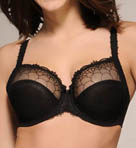 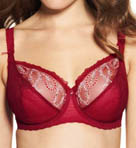 Back to top Soft CupsThis is the name given to wire-free or wireless cups. Soft cup bras can have seams and padding as well – just no underwires. Back to top |
|||||

